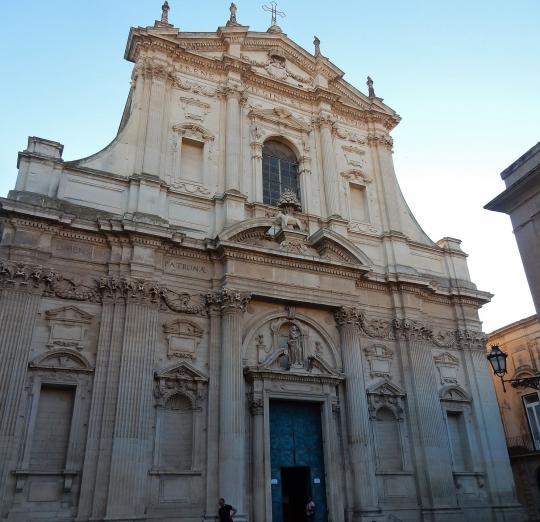Church of Sant’Irene, Lecce, 1591-1639. Image in the public domain.
In 1587 the chapter of the Theatine Order of Lecce accepted a donation of one thousand ducati for the construction of the order’s new casa and “a new church in the name of Sant’Irene, virgin and martyr, and the patroness of the city,” whose relics were to be kept and venerated inside the building. This gesture was followed by other donations from Leccese noblemen that supported design and construction works. These were supervised by Theatine architect Francesco Grimaldi, who, along with Giacomo della Porta, had been a key figure in the construction of the order’s main church in Rome, Sant’Andrea della Valle. It is known that by this time Grimaldi made drawings and a wooden model of the church. However, its construction began only in 1591 and continued into the seventeenth century, with the transept, choir and part of the nave finished by 1602. Although still missing structural and decorative elements, by 1607 the church was already recognized as one of the city’s landmarks and as an artistic achievement. The words of chronicler Peregrino Scardino of 1607 exemplify the admiration the building provoked: “immense and magnificent temple of Solomon that...once it has attained all of its furnishings (...) it would seem discreet to compare it to the greatest church in Italy”. In such way, Scardino mobilized a frequent comparison in contemporary laudatory literature that suggested a material and symbolic proximity between Sant’Irene’s Church and the Temple of Jerusalem, the ultimate model of divine building. At the same time, he generated expectations about a rich decorative program that was to be executed.
The ideas in Scardino’s Discorso materialized throughout the seventeenth century as the church’s main altar and chapels were decorated with elaborate altarpieces, some carved in wood and others in stone by local sculptors. The main altar, executed by Pietro Caracciolo, showcased three gilded tiers that measured five meters high, and which produced four facades decorated with paintings and sculptures, very much echoing the structural and aesthetic features seen in works of ephemeral architecture built in the Hispanic world.
As Mario Cazzato has asserted, the Church of Sant’Irene created an architectonic and urbanistic impact that established a new paradigm for the arts of Apulia. In many ways, this church can be considered—as Cazzato says—a “laboratorio d’incubazione”: a laboratory where formal and stylistic innovations took place. Consolidating the church’s role in this respect, its decorative program included a series of altarpieces that, although not as massive and visually striking as the main altarpiece, brought to the Leccese context the Solomonic column, a structural, ornamental and symbolic element that was gaining popularity in the designs of altarpieces (retablos) in and outside the realms of the Hispanic monarchy.
Introducing what would become an iconic feature of “Leccese Baroque,” the altar originally dedicated to San Gaetano de Thiene, and later to Sant’Oronzo, constitutes the first adaptation of the Solomonic column to the retablo structure in this city. Designed and executed by sculptor Francesco Antonio Zimbalo (Lecce, 1567-c. 1631) in 1630, this stone altarpiece displays a layout that features a niche flanked by two pairs of Solomonic columns with Corinthian capitals and a broken pediment, a formal solution that was transformed later within the same church in the altar dedicated to Sant'Irene by Francesco Antonio’s grandson, Giuseppe Zimbalo (Lecce, 1620-1710). It would later reappear in the altars dedicated to San Carlo Borromeo, Anime del Purgatorio, Santo Stefano and the Angeli Custodi, within the same church, and also in others at the Church of Santa Croce and the Church of San Giovanni. Although Leccese altarpiece production still requires in-depth research, the prevalence of Solomonic columns is a remarkable feature that points at compelling cultural and artistic connections between this region and other realms of the Catholic world of this time (Altar de los Reyes, 1630-1639, Cathedral of Puebla, Mexico). Some of these relationships can be linked with the existing knowledge about Giacomo Vignola’s Regola of 1562, Bernini’s baldacchino (completed in 1634) and especially, of the spiral columns of the Shrine of St. Peter, which since the late Middle Ages were believed to have belonged to the Temple of Solomon.
November 10, 2019
Bibliography
Cazzato, Mario, and Vincenzo Cazzato. Lecce e il Salento. Rome: De Luca, 2015.
Cazzato, Mario. “Fonti per la storia di una città barocca: I Teatini leccesi dalla fondazione (1586) all’inchiesta innocenziana (1649).” Bollettino Storico di Terra d’Otranto 2 (1992): 5-50.
Cazzato, Mario. “Scultori e scultori-architetti dal Seicento al primo Settecento salentino.” In Sculture di età barocca tra Terra d’Otranto, Napoli e Spagna, edited by Raffaele Casciaro and Antonio Cassiano, 131-42. Rome: De Luca, 2007.
Cazzato, Vincenzo, and Simonetta Politano. “L’altare barocco nel Salento: Da Francesco Antonio Zimbalo a Mauro Manieri.” In Sculture di età barocca tra Terra d’Otranto, Napoli e Spagna, edited by Raffaele Casciaro and Antonio Cassiano, 107-30. Rome: De Luca, 2007.
Cazzato, Vincenzo. “Costanti grammaticali e sintattiche nelle architetture di Giuseppe Zimbalo.” Annali del barocco in Sicilia 9 (2017): 17-32.
Foscarini, Amilcare. Arte e artisti di Terra d’Otranto: Tra medioevo ed età moderna. Lecce: Edizioni del Grifo, 2000.
Halcón, Fátima, Francisco Herrera, and Álvaro Recio, eds. El retablo sevillano: Desde sus orígenes a la actualidad. Seville: Diputación Provincial de Sevilla, 2009.
Martín González, Juan José. El retablo barroco en España. Madrid: Editorial Alpuerto, 1993.
Pellegrino, Bruno. “La ‘religiosa magnificenza’ di Lecce nel panorama di Terra d’Otranto.” In Lecce e il Salento, edited by Vincenzo Cazzato and Mario Cazzato, 23-30. Rome: De Luca, 2015.
Ward Perkins, J. B. "The Shrine of St. Peter and Its Twelve Spiral Columns." The Journal of Roman Studies 42 (1952): 21-33.
Rodríguez G. de Ceballos, Alfonso. Retablos de la Comunidad de Madrid: Siglos XV al XVIII. Madrid: Dirección General de Patrimonio Histórico-Comunidad de Madrid, 2002.
Núñes-Méndez, Elsaris. “The Church of Sant’Irene dei Teatini and its Solomonic Altarpieces.” In Michael Cole and Alessandra Russo, eds. Spanish Italy & The Iberian Americas. New York, NY: Columbia University 2019. <https://doi.org/10.7916/req9-8267>


